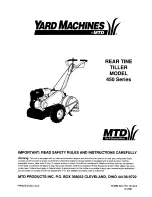
JOHNSON CONTROLS
21
FORM 160.77-O1
ISSUE DATE: 10/22/2020
SECTION 3 - MAINTENANCE
CHECKING SYSTEM FOR LEAKS
Leak Testing During Operation
The refrigerant side of the system is carefully pressure
tested and evacuated at the factory. However, after the
system has been charged, the system should be care-
fully leak tested with a R-134a compatible leak detec-
tor to be sure all joints are tight.
If any leaks are found, they must be repaired immedi-
ately. Usually, leaks can be stopped by tightening flare
nuts or flange bolts; however, for any major repair, the
refrigerant charge must be removed. Refer to
Handling
Refrigerant For Dismantling And Repairs
in this section.
Never perform welding on the chiller un
-
less the refrigerant has been completely
evacuated and all other safety measures
have been taken.
Testing for Evaporator and Condenser Tube
Leaks
Evaporator and condenser tube leaks in R-134a sys-
tems may result in refrigerant leaking into the water
circuit, or water leaking into the shell depending on the
pressure levels. If refrigerant is leaking into the water,
it can be detected at the liquid head vents after a period
of shutdown. If water is leaking into the refrigerant,
system capacity and efficiency will drop off sharply. If
a tube is leaking and water has entered the system, the
evaporator and condenser should be valved off from
the rest of the water circuit and drained immediately
to prevent severe rusting and corrosion. The refriger-
ant system should then be drained and purged with dry
nitrogen to prevent rusting and corrosion. If a tube leak
is indicated, the exact location of the leak may be de-
termined as follows:
1. Remove the heads and listen at each section of
tubes for a hissing sound that would indicate gas
leakage. If the probable location of the leaky tubes
has been determined, treat that section in the fol-
lowing manner (if the location is not definite, all
the tubes will need to be checked).
2.
Wash off both tube heads and the ends of all tubes
with water.
Do not use carbon tetrachloride for this
purpose since its fumes give the same
flame discoloration that the refrigerant
does.
3. With nitrogen or dry air, blow out the tubes to
clear them of traces of refrigerant laden moisture
from the circulation water.
4. As soon as the tubes are clear, a cork should be
driven into each end of the tube.
5. Pressurize the dry system with 50 to 100 PSIG
(345 to 690 kPa) of nitrogen. Repeat this with all
of the other tubes in the suspected section or, if
necessary, with all the tubes in the evaporator or
condenser.
6. Allow the evaporator or condenser to remain
corked up to 12 to 24 hours before proceeding.
Depending upon the amount of leakage, the corks
may blow from the end of a tube, indicating the
location of the leakage. If not, if will be neces-
sary to make a very thorough test with the leak
detector.
7. After the tubes have been corked for 12 to 24
hours, it is recommended that two people, work-
ing at both ends of the evaporator, carefully test
each tube, – one person removing corks at one
end and the other at the opposite end to remove
corks and handle the leak detector. Start with the
top row of tubes in the section being investigated.
Remove the corks at the ends of one tube simul-
taneously and insert the exploring tube for 5 sec-
onds – this should be long enough to draw into
the detector any refrigerant gas that might have
leaked through the tube walls. A fan placed at the
end of the evaporator opposite the detector will
assure that any leakage will travel through the
tube to the detector.
8.
Mark any leaking tubes for later identification.
9. If any of the tube sheet joints are leaking, the leak
should be indicated by the detector. If a tube sheet
leak is suspected, its exact location may be found
by using a soap solution. A continuous buildup of
bubbles around a tube indicates a tube sheet leak.
3














































